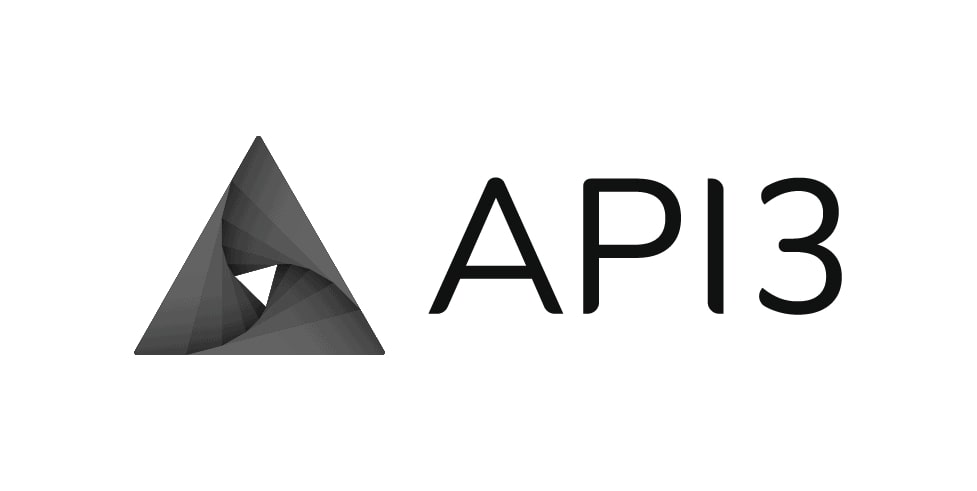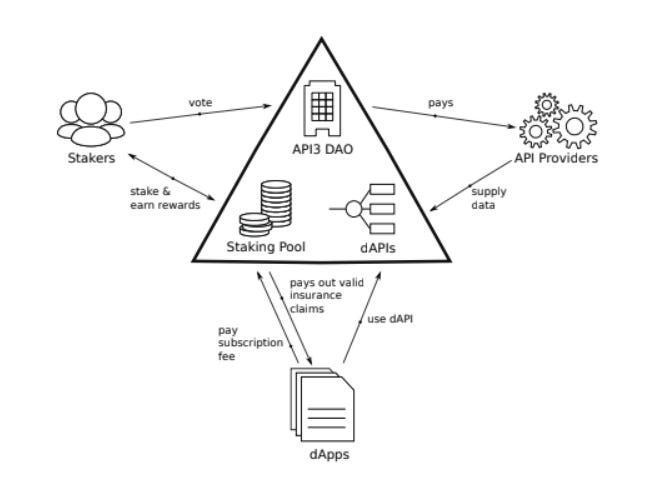API3, the first-party blockchain oracle, is releasing beacon data feeds with Amberdata
In the fragmented ecosystem that Web3 is at this time, interoperability is a key goal in order to make progress. Blockchain oracles are a fundamental part of the so-called Web3 ecosystem, as they can help achieve this goal. Their role is to mediate between various blockchains, and data sources that lie beyond them.
As Cointelegraph notes, oracle projects are seeing bullish momentum as crypto startups intensify their focus on interoperability in 2022. In this column, we’ve been keeping track of Chainlink, which is the market leader in oracles in terms of market capitalization as reported by Cointelegraph.
Today, API3, a top 5 blockchain oracle project as per Cointelegraph, is releasing Beacons, which it dubs “a transparent, scalable, and cost-effective solution for data providers to publish data feeds.” We connected with Heikki Vänttinen, co-founder of API3, to discuss API3’s approach to oracles, and what this release signifies.
API3: Building on lessons learned from running an oracle service for API providers
API3 is a relatively young project. It was started in 2020 by Vänttinen and a group of co-founders, some of whom were previously involved in the Honeycomb API Marketplace. Honeycomb was live between 2019 and 2021, and its main thesis was that the oracle problem is not technical in nature. Rather, the main difficulty is to get a large variety of independent and competing actors to cooperate in a decentralized way and achieve business outcomes.
However, as noted by Burak Benligiray, one of API3’s co-founders, “technical solutions can be designed in a way to conceive an ecosystem where this can feasibly happen.” This is what API3 is out to achieve. API3 currently has around 50 contributors and has received a $3 million seed round of investment, led by Placeholder, accompanied by Pantera Capital, Accomplice, CoinFund, Digital Currency Group, and Hashed.
Benligiray wrote that Honeycomb acted as a laboratory and an incubator for API3. It affirmed the team’s view that API providers must be considered a critical component of an oracle and paved the way for API3 to become the API-centric solution it is today. But what exactly is meant by that?
Essentially, Honeycomb functioned as a layer running on top of Chainlink’s open-source oracle software. Eventually, however, this approach reached its limits, and the team felt it was time to move on. Benligiray cites some key issues with Honeycomb, which led to the development of API3.

API3 is a bold effort to achieve decentralization in connecting Web3 applications to the outside world
The existing oracle ecosystem model only considers oracles and dApps (decentralized Web3 applications running on a blockchain, typically Ethereum). API3 added the API providers as a third group to better represent the situation. API3 believes this model is more accurate, but it has also proven itself to be very complex due to having to make sure that three different parties play along.
The solution posed by API3 is to cut out the oracle node operator group as the middlemen and have the API providers operate their own oracle nodes, which greatly simplifies the ecosystem model (APIs and dApps).
Honeycomb was acting as a middleman between APIs and oracle nodes to facilitate the integration. The plan was to use this initial model to bootstrap the platform, and then move on to a solution with a trustless integration path. However, their research showed that the only acceptable option was for the API provider to operate the full oracle node, and none of the alternatives were as trust-minimized.
In other words, most blockchain oracles act as middlemen. This means they are single points of failure, and that they have to be trusted by both their users and the API providers. The single point of failure vulnerability can be addressed by introducing decentralization internally at the oracle level, as Chainlink has done. However, oracles still function as de facto points of centralization.
API3’s Whitepaper lists the issues with this approach, including vulnerability, middleman tax, ineffective redundancy, and lack of transparency. There is a paradox there. The fact that Web3 is theoretically supposed to be all about decentralization, while in practice de facto points of centralization are introduced, has been at the epicenter of widely cited criticism by the likes of Silicon Valley veteran Tim O’Reilly and Signal’s founder Moxie Marlinspike.
First-party blockchain oracles: cutting out the middlemen
API3’s answer to this paradox is to move towards a decentralized version of oracles, what it calls “a first-party blockchain oracle,” by enabling API providers to run their own oracle. This is made possible via an open-source piece of software called Airnode, which API3 implements and makes available for API providers to run on their own.
The promise, as laid out in API3’s Whitepaper, is that Airnodes are fully-serverless oracle nodes designed specifically for API providers to operate their own oracles, and address all of the oracle node-related problems API3 identifies. That is, it does not require any specific know-how to operate, or any day-to-day maintenance.
Airnode is built on services priced on-demand, meaning that the node operator is charged only as much as their node is used. It does not require the node operator to handle cryptocurrency at all, and its protocol is designed in a way that the requester covers all gas costs, API3’s Whitepaper claims.
One way to see Airnode, API3’s Whitepaper states, is as a lightweight wrapper around a Web API that allows it to communicate with smart contract platforms with no overhead or payment token friction. Regarding the level of involvement required from the API provider, using Airnode can be likened to utilizing an API gateway that makes an API accessible over the Web, rather than operating a blockchain node as a side-business.

Overview of API3 mechanics
That sounds like an attractive proposition for API providers, and a few of them have jumped on board already. API3 has created the API3 Alliance, a group of API providers who utilize Airnodes to make their APIs available directly to Web3 applications, cutting out the oracle middleman. Web3 applications can call API provider-run oracles directly, aided in discovering them by API3’s service.
That’s great for Web3 application developers, and API providers, but what about API3? Do they get anything out of it? Our understanding after discussing with Vänttinen is “not really”, which sounds like a very unsustainable business model at first. But this is where API3’s business model diverges from the norm. Instead of taking a cut from transactions, API3 aims to function as an insurance service provider.
API3 will co-develop an on-chain insurance service with Kleros, an on-chain dispute resolution protocol, to provide quantifiable and trustless security guarantees to users. This insurance service will protect users against damages caused by certain malfunctions, which are known to have happened in oracle services, up to a payout limit. It’s an interesting idea, one which brings us to today’s announcement.
API3 Beacons: from data to data feeds
Vänttinen said that the operation of API3 as an on-chain insurance service is not yet fully in place. They are, however, working in that direction, and releasing Beacons is a major step. What Beacons do, essentially, is that they create data feeds by wrapping Airnodes. Airnodes function on a request-response model. This means that users interested in receiving updates will have to constantly poll Airnodes.
In certain types of Web3 applications, however, having access to the latest data updates is critical. Beacons enable that, although this comes at a cost — literally. Unlike Chainlink, for example, API3 Beacons store all their data updates on-chain. This means that there is a cost in the native (Ethereum) gas token associated both for the API provider, as well as for Beacon users. This is why, as Vänttinen acknowledged, Beacons won’t make sense for everyone.
Still, he asserted, Beacons will be the building blocks of API3 dAPIs, alongside being offered as a standalone service. dAPI is the term API3 uses to refer to a “new generation of decentralized APIs.”
dAPIs are meant to be a secure and cost-efficient solution to provide a traditional API service to smart contracts in a decentralized way, composed of multiple APIs, a decentralized network of first-party oracles, and a decentralized governing entity to oversee the oracle network.
The latter is the role API3 sees for the API3 decentralized autonomous organization (DAO). API3 token holders can stake to obtain direct voting privileges in the API3 DAO, which is how API3 governance takes place. The staked API3 tokens will back an on-chain insurance service as collateral to provide dAPI users with quantifiable and trustless security guarantees.
The entire approach sounds ambitious, forward-looking, and complicated in equal measures. Either way, Beacons are a key part of the process. To empower immediate traction on Beacons, API3 is partnering with Amberdata, a leading provider of digital asset data and insights into blockchain networks, crypto markets, and decentralized finance, to launch official Amberdata Beacons at ETHDenver.
In tandem with the launch, API3 is serving as the official DeFi Track sponsor of ETHDenver, dubbed as the largest and longest-running Ethereum event in the world. API3 aims to attract more than 3,000 dApp developers and have a strong presence at the event by ensuring that developers are equipped with the tools and knowledge to successfully build on Amberdata Beacons over the course of the nine-day event.





Pingback: micro step